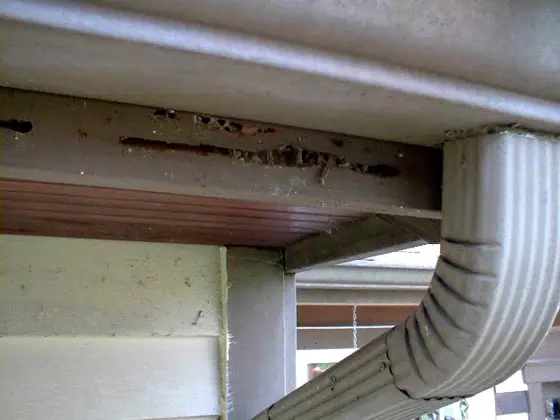Carpenter Bees

Look what those devils did to my gutter board! This channel was done by a carpenter bee in just a few days.
DEAR TIM: Every spring my house seems to attract large menacing bees or hornets. They show up out of nowhere and actually drill holes into the sides and other parts of my house. To make it worse, they keep me awake at night with their constant munching and crunching. What can be done to make these pest go away? What is the best way to repair the damage? Is there something I can do to repel these buzzing devils? Marie H., Philpot, KY
DEAR MARIE: I've got news for you. The insects you are talking about don't just stop by each spring, they are probably permanent residents. It sounds to me like you have an infestation of carpenter bees. The small holes that you see in your siding, soffits, window frames, etc. are actually the entryway to the nests where the bees raise their young. These bees love to drill into bare or unpainted softwoods. Redwood, pine, cypress and cedar seem to be their favorite wood species.
Carpenter bees are often confused with their cousins, regular bumble bees. A carpenter bee is usually 2/3 to one inch long and has a shiny black abdomen. A bumble bee is often slightly smaller and has a fuzzy abdomen with yellow markings. Bumble bees can and do sting with a vengeance. Male carpenter bees often frighten people because they fly close to their heads and hover as if they are going to attack. This activity is their only method of defense because Mother Nature failed to equip them with a stinger. Female carpenter bees can sting but they often only do so if you provoke them at or near their nesting sites.
Every spring male and female carpenter bees mate. The females then begin to build nests. They can drill new ones or remodel existing nest chambers from the previous year. The nesting chambers that extend from the entry holes can be extensive ranging from 6 inches to several feet long. The female carpenter bee is actually very resourceful and creates a maze like structure with twists and turns within the wood. There are small dead end branches off the main tunnels where a single egg is laid. The mama bee stores a glob of pollen next to the freshly laid egg. She then seals off this chamber. The baby carpenter bees develop into adults by the end of the summer but stay put in your wood siding, windows, trim, etc. until the following spring when they finally emerge to drill additional holes in your house.
Killing adult carpenter bees is not the best way to solve the problem. By the time you react to the bees presence, they have possibly already laid their eggs. The long term solution is to kill the developing larvae. Professional pest control people have found that blowing an insecticidal dust into the nest chambers seems to work best. If you do this early in the nesting process, the female carpenter bee carries the dust back to each egg site as she deposits the pollen food store for each egg. Look for a dust that contains a 5 percent carbonyl content. Use a sprayer or duster that has a long snout that can inject the dust deep into the wood.
Once the nests have been treated with dust, leave them alone for a week or so. This will allow the female bee plenty of time to distribute the dust within the chambers. Use small corks or pieces of wood dowel rod to fill the entry holes. Glue them in place once you have achieved a tight fit. The presence of freshly drilled holes tells you that new nesting activity is happening and that you must continue to dust the new chambers.
The best preventive measures are to keep susceptible wood painted. Semi-transparent stains are not an effective repellent. People who live in log homes or other wood sided structures that are not painted can apply chemical treatments, but these moisture sensitive chemicals often need to be re-applied every 2 to 4 weeks to prevent carpenter bees from boring into wood. This can be a maintenance headache, but is your only choice if you want the natural look of wood.
Column 314
2 Responses to Carpenter Bees